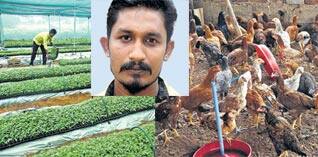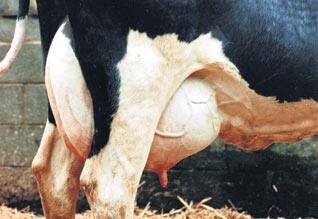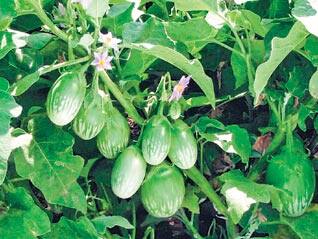
நமது நாட்டில் ஆடுகள் பெரும்பாலும் பாரம்பரிய முறைகளிலேயே பராமரிக்கப்பட்டு வருகின்றன. ஆடுகளை விவசாய நிலங்களில் பட்டி போட்டு அடைத்தோ, மரநிழல்களில் அல்லது வீட்டை ஒட்டிய சிறு தடுப்புகளில் அடைத்தோ வளர்த்து வருகின்றனர். குறைந்து வரும் மேய்ச்சல் நிலங்கள், வனப்பகுதியில் ஆடுகளை அனுமதிக்காமல் இருப்பது போன்ற தற்போதைய சூழ்நிலையில் ஆடுகளை கொட்டகை அமைத்து பரண்மேல் வளர்ப்பதே சிறந்தது என தேனி உழவர் பயிற்சி மைய பேராசிரியர் அ.செந்தில்குமார் தெரிவித்தார்.
அவர் கூறியது: கனமழை, அதிக வெயில், குளிர்காற்று, பனி, கொடிய விலங்குகள் மற்றும் திருட்டு ஆகியவற்றில் இருந்து வெள்ளாடுகளைப் பாதுகாக்கவும், சிறந்த முறையில் வெள்ளாடுகளை வளர்க்கவும் கொட்டகை அமைப்பது மிக அவசியம். கொட்டகைகளை மேட்டுப்பாங்கான இடத்தில் அமைக்க வேண்டும். கொட்டகை சுத்தமாகவும், காற்றோட்டம், வெளிச்சத்துடனும் இருக்க வேண்டும். கொட்டகையின் கூரையை பனை அல்லது தென்னை ஓலை கொண்டு அமைக்கலாம். அஸ்பெஸ்டாஸ் கொண்டும் கூரையை அமைக்கலாம். கொட்டகையின் நீளப்பகுதி கிழக்கு மேற்காகவும், அகலப் பகுதி வடக்கு தெற்காகவும் இருக்க வேண்டும். இதன் மூலம் கொட்டகையினுள் நல்ல காற்றோட்டமும், குறைவான சூரிய வெப்பத்தையும் பெறலாம்.
கொட்டகை அமைப்பு: கொட்டகையின் கூரையை அஸ்பெஸ்டாஸ் கூரை கொண்டு அமைத்தால் உயரம் 10-12 அடி உள்ளவாறு அமைக்க வேண்டும். பிற பொருள்களைக் கொண்டு கூரை அமைத்தால், உயரம் 8-10 அடி உள்ளவாறு அமைக்க வேண்டும். கொட்டகையைச் சுற்றி 1 அடி உயரத்தில் சுவர் அமைத்து, அதன் மீது 5 அடி உயரத்திற்கு கம்பி வலை அல்லது மூங்கில் தட்டிகள் அல்லது மரச்சட்டத்தினால் ஆன தட்டிகளை அமைக்கலாம். கொட்டகையின் அளவு, அதில் அடைக்கக் கூடிய ஆடுகளின் எண்ணிக்கைக்கு ஏற்ப அமையும். ஒரு வளர்ந்த வெள்ளாட்டிற்கு ஏறத்தாழ 12-15 சதுர அடி இடவசதி தேவை. எனவே, 50 ஆடுகளுக்கு கொட்டகை அமைப்பதாக இருந்தால் 600 சதுர அடி இடவசதி அவசியம். கொட்டகையின் நீளம் எவ்வளவு வேண்டுமானாலும் இருக்கலாம். ஆனால் அகலம் 20 அடிக்கு குறைவாக இருக்க வேண்டும்.
ஆடுகளை இரவில் மட்டும் கொட்டகையில் அடைத்து பகலில் மேய்ச்சலுக்கு அனுப்புவதாக இருந்தால், மேற்கண்ட 600 சதுர அடி இடவசதி போதுமானது. ஆனால் ஆடுகள் நாள் முழுவதும் கொட்டகையில் இருக்கும் "கொட்டில்" முறையில் வளர்ப்பதாக இருப்பின் அதே அளவு இடவசதி கொட்டகையை ஒட்டிய திறந்த வெளி பகுதியில் கொடுக்கப்பட வேண்டும். இது ஆடுகள் சுதந்திரமாக நடமாடவும், கொட்டகையில் சாணம் மற்றும் சிறுநீர் அதிகம் சேராமலிருக்கவும் தேவைப்படுகிறது.
கொட்டகையின் நீளத்தை ஆடுகளின் எண்ணிக்கைக்கு ஏற்ப அதிகரித்துக் கொள்ளலாம். அதிக பட்சம் 100 ஆடுகள் வரை ஒரு கொட்டகையில் அடைக்கலாம். அதிலும் குட்டிகள், கிடாக்கள் இவற்றிற்கு தனித்தனி தடுப்புகள் அமைப்பது சிறந்தது. கொட்டகையின் அகலம் நம் நாட்டு தட்ப வெப்ப நிலைக்கு ஏற்ப 20 அடிக்கு குறைவாக இருப்பதே நல்லது. அதற்கு மேல் அதிகரிக்கும் போது காற்றோட்டம் பாதிக்கப்பட்டு கொட்டகையில் அம்மோனியா வாயுவின் தாக்கம் காணப்படும். இது போலவே கொட்டகையின் உயரம் முக்கியமானது. கொட்டகையின் கூரை அஸ்பெஸ்டாஸ், மங்களூர் ஓடு அல்லது கீற்றுகளைக் கொண்டு அமைக்கலாம். கீற்றுக் கொட்டகை அமைத்தல் செலவினைக் குறைத்தாலும் தீப்பிடிக்கும் அபாயம், பூச்சிகளின் தொல்லை, அடிக்கடி மாற்ற வேண்டிய சிரமம் போன்ற சில பாதகமான விளைவுகளைத் தரும். அஸ்பெஸ்டாஸ் கூரை அமைப்பது கொஞ்சம் செலவு அதிகம் என்றாலும் நிரந்தரமான ஒன்று. துத்தநாகத் தகடு (தகரம்) கொண்டும் கூரை அமைக்கலாம்.
சல்லடைத் தரை அல்லது பரண்மேல் ஆடு வளர்ப்பு:
உயர் ரக ஆடுகளை வைத்திருப்போர் சல்லடைத்தரை அமைப்பு முறையிலும் தரையை அமைக்கலாம். இதில் தரையிலிருந்து சுமார் 3 முதல் 4 அடி உயரத்தில் 1 முதல் 2 அடி அங்குல அகலம் கொண்ட மரச்சட்டங்களை 1 அங்குல இடைவெளி விட்டு வரிசையாக அடிக்கப்பட்டு அதன் மேல் ஆடுகள் விடப்படும். ஆடுகளின் சாணம் தரையில் தங்காமல் இடைவெளிகள் வழியாக கீழே விழ வேண்டும். இவ்வாறு அமைப்பதால் ஆடுகளின் சாணம் மற்றும் சிறுநீர் கீழே விழுந்து விடும். இதன் மூலம் ஆடுகள் நோய் பாதிப்பின்றி சுகாதாரமாக இருக்க வழி வகுக்கும். இம்முறையில் கொட்டகையினை பராமரித்தால் ஆடுகள் சுகாதாரமாகவும், அதிக எடையுடனும் காணப்படும். இம் முறையில் கொட்டகையை தினமும் சுத்தம் செய்ய அவசியம் இல்லை. சாணம் ஓரளவு சேர்ந்த பிறகு அகற்றினால் போதும்.
இடவசதி: குட்டிகளுக்கு 4 சதுர அடியும், பெட்டை ஆடுகளுக்கு 10 முதல் 15 சதுர அடியும் மற்றும் கிடாக்களுக்கு 15முதல் 20 சதுர அடியும் இடவசதி கொடுக்க வேண்டும். அதிக அளவில் ஆடுகளை ஒரே கொட்டகையில் அடைத்தால் ஒன்றோடொன்று சண்டையிட்டு காயங்களையும், கருச்சிதைவையும் உண்டாக்கும். மேலும், நோய்த்தாக்கமும் அதிகமாக இருக்கும். கொட்டகையில் கிடாக்கள், சினை ஆடுகள், குட்டிகள், தாய் ஆடுகளை தனித் தனியாகப் பிரித்து அடைக்க வேண்டும். எனவே, கொட்டகையில் கம்பி வலை கொண்டோ அல்லது மூங்கில் தட்டிகள் கொண்டோ சிறு சிறு அறைகளாக பிரித்து அதில் ஆடுகளை வைத்து வளர்த்தல் நல்லது.
தண்ணீர் தொட்டி மற்றும் தீவனத் தொட்டியின் அமைப்பு :
ஆடுகள் நீர் பருகுவதற்கு வட்ட வடிவிலான அல்லது நீள் செவ்வக வடிவிலான சிமெண்ட் தொட்டிகள் இருப்பது சிறந்தது. இவற்றை தினமும் சுத்தம் செய்ய வேண்டும். வாரம் ஒரு முறை உள்பக்கம் சுண்ணாம்பு அடிக்க வேண்டும். ஏறத்தாழ 20 ஆடுகளுக்கு ஒரு தொட்டி தேவை. இரும்புத்தகடு அல்லது மரத்தினால் ஆன தீவனத் தொட்டிகளை அரை வட்ட வடிவில் அமைக்க வேண்டும். இதன் நீளம் 5 முதல் 6 அடி இருக்கலாம். 10 முதல் 12 ஆடுகளுக்கு ஒரு தீவனத் தொட்டி தேவை.
தீவனத் தொட்டியை ஆடுகள் அசுத்தம் செய்வதை தடுக்க தலையை மட்டும் நுழைக்கும் அளவிற்கு கம்பித் தடுப்புகள் அமைக்கலாம். இவற்றை அடர் தீவனம் மற்றும் வெட்டப்பட்ட பசுந்தீவனங்கள் அளிப்பதற்கு பயன்படுத்தலாம்.
கொட்டில் முறை வெள்ளாடு வளர்ப்பின் பயன்கள்:
வெள்ளாடுகளை மேய்ச்சலுக்கு எடுத்துச் செல்வதனால் அதன் சக்தி விரயமாவதோடு அதன் உடல் எடை குறையும். ஆடுகளுக்குத் தேவையான பசுந்தீவனங்களை உற்பத்தி செய்து கொட்டகையிலேயே ஆடுகளை வைத்து கொடுக்கும் போது அதன் உடல் எடை வெகுவிரைவில் கூடுவதால் அதிக இலாபத்திற்கு ஆடுகளை விற்கலாம். ஆடுகளை 12 மாதங்கள் வரை காத்திருக்காமல் 6 முதல் 8 ஆவது மாதங்களிலேயே விற்பனை செய்யலாம். அதிக எடையுடைய குட்டிகளைப் பெறலாம். நோய் பாதிப்பு அதிகம் இருக்காது. குட்டிகளின் இறப்பைக் குறைக்கலாம்.பராமரிப்பு எளிது. அறிவியல் முறையில் பராமரிக்கவும், தீவனம் அளிக்கவும், நோய் தடுப்பு முறைகளை மேற்கொள்ளவும் எளிதாகிறது. குறைந்த இடத்தில் அதிக எண்ணிக்கையில் ஆடுகளை வளர்க்க முடியும்.எரு சேமிக்கப்பட்டு நிலத்திற்கு உரமாகக் கிடைக்கின்றது என்றார்.
Source : Dinamani

















